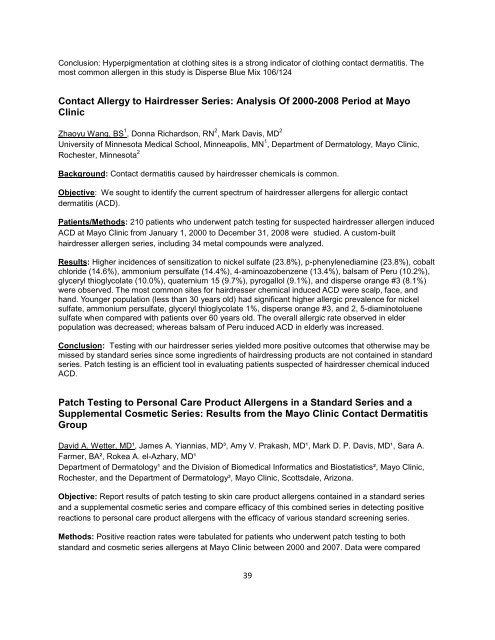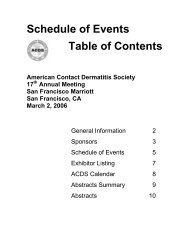American Contact Dermatitis Society 21 Annual Meeting
American Contact Dermatitis Society 21 Annual Meeting
American Contact Dermatitis Society 21 Annual Meeting
Create successful ePaper yourself
Turn your PDF publications into a flip-book with our unique Google optimized e-Paper software.
Conclusion: Hyperpigmentation at clothing sites is a strong indicator of clothing contact dermatitis. The<br />
most common allergen in this study is Disperse Blue Mix 106/124<br />
<strong>Contact</strong> Allergy to Hairdresser Series: Analysis Of 2000-2008 Period at Mayo<br />
Clinic<br />
Zhaoyu Wang, BS 1 , Donna Richardson, RN 2 , Mark Davis, MD 2<br />
University of Minnesota Medical School, Minneapolis, MN 1 , Department of Dermatology, Mayo Clinic,<br />
Rochester, Minnesota 2<br />
Background: <strong>Contact</strong> dermatitis caused by hairdresser chemicals is common.<br />
Objective: We sought to identify the current spectrum of hairdresser allergens for allergic contact<br />
dermatitis (ACD).<br />
Patients/Methods: <strong>21</strong>0 patients who underwent patch testing for suspected hairdresser allergen induced<br />
ACD at Mayo Clinic from January 1, 2000 to December 31, 2008 were studied. A custom-built<br />
hairdresser allergen series, including 34 metal compounds were analyzed.<br />
Results: Higher incidences of sensitization to nickel sulfate (23.8%), p-phenylenediamine (23.8%), cobalt<br />
chloride (14.6%), ammonium persulfate (14.4%), 4-aminoazobenzene (13.4%), balsam of Peru (10.2%),<br />
glyceryl thioglycolate (10.0%), quaternium 15 (9.7%), pyrogallol (9.1%), and disperse orange #3 (8.1%)<br />
were observed. The most common sites for hairdresser chemical induced ACD were scalp, face, and<br />
hand. Younger population (less than 30 years old) had significant higher allergic prevalence for nickel<br />
sulfate, ammonium persulfate, glyceryl thioglycolate 1%, disperse orange #3, and 2, 5-diaminotoluene<br />
sulfate when compared with patients over 60 years old. The overall allergic rate observed in elder<br />
population was decreased; whereas balsam of Peru induced ACD in elderly was increased.<br />
Conclusion: Testing with our hairdresser series yielded more positive outcomes that otherwise may be<br />
missed by standard series since some ingredients of hairdressing products are not contained in standard<br />
series. Patch testing is an efficient tool in evaluating patients suspected of hairdresser chemical induced<br />
ACD.<br />
Patch Testing to Personal Care Product Allergens in a Standard Series and a<br />
Supplemental Cosmetic Series: Results from the Mayo Clinic <strong>Contact</strong> <strong>Dermatitis</strong><br />
Group<br />
David A. Wetter, MD¹, James A. Yiannias, MD³, Amy V. Prakash, MD¹, Mark D. P. Davis, MD¹, Sara A.<br />
Farmer, BA², Rokea A. el-Azhary, MD¹<br />
Department of Dermatology¹ and the Division of Biomedical Informatics and Biostatistics², Mayo Clinic,<br />
Rochester, and the Department of Dermatology³, Mayo Clinic, Scottsdale, Arizona.<br />
Objective: Report results of patch testing to skin care product allergens contained in a standard series<br />
and a supplemental cosmetic series and compare efficacy of this combined series in detecting positive<br />
reactions to personal care product allergens with the efficacy of various standard screening series.<br />
Methods: Positive reaction rates were tabulated for patients who underwent patch testing to both<br />
standard and cosmetic series allergens at Mayo Clinic between 2000 and 2007. Data were compared<br />
39






